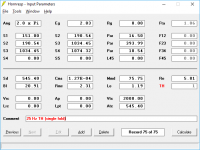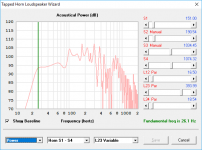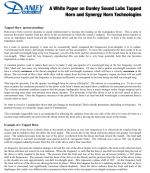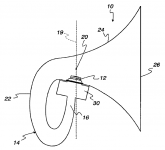Again, nothing on that last page of an 84 page thread. For actual link, I advance searched keyword: cowan, user name: gm to get the post: Collaborative Tapped horn projectGM: This is Your simulation I found for William Cowans 30hz Tapped horn That MikeHunt used with the Eminence Magnum Pro 12HO
and a Link to this Page.
Collaborative Tapped horn project
I bassically used the same enclosure, with some length added.. (81.22cm)
So the final Horn was 2220Tall with a very slightly larger port. I used the eminence definimax 12
Simply this. but longer/lower tuned. Should model and be as 25hz-75hz?
OK, same sim except 81.22 cm longer using the 4012HO in 2pi space: phantom line is with lossy inductance, though with such a low Xmax combined with a tuning so far below Fs, seriously doubt it's an issue.
Bottom line, it should play from 25-75 Hz with BW to spare.
GM
Attachments
4012HO in 2pi space [naudio's pdf]: phantom line is with lossy inductance, though with such a low Xmax combined with a tuning so far below Fs, seriously doubt it's an issue.
Bottom line, it should play from 25-75 Hz with BW to spare.
GM
Bottom line, it should play from 25-75 Hz with BW to spare.
GM
Attachments
I'll be making the optimization spreadsheet available from my site once I've finished work on it.
If you're interested, I've uploaded a usable copy of the workbook to my website, at the link below:
The Subwoofer DIY Page - Horn Folding
If you're interested, I've uploaded a usable copy of the workbook to my website, at the link below:
The Subwoofer DIY Page - Horn Folding
Brian, Could I see what Your resim is bassed on the Eminence definimax12ho,
Very appreciated,
Im looking for the most bass possible (in the 27-60hz ish range) sealed doesnt sound that efficent.. SQ < SPL
I cant be the only one who dreams of building the sickest lowbass killer? No size limit on the enclosure, no limits what so ever tbh just hoping some type of a horn box or «cool» enclosure type works with those woofers as i have them just laying around, and these are not the cheap looking pa woofers you tend to see on these builds,
Just thought maybe a sick box with a sick driver would make for a good combo
You aren't the only one and I applaud your enthusiasm young man...
Im looking for the most bass possible (in the 27-60hz ish range) sealed doesnt sound that efficent.. SQ < SPL
I cant be the only one who dreams of building the sickest lowbass killer?
SPL @ highest possible SQ; this is what compression loaded concrete bass horns are for and plenty of folks dream of such things, just few can and/or willing to sacrifice other aspects of the 'good life' to attain it.
GM
Brian, Could I see what Your resim is bassed on the Eminence definimax12ho,
Very appreciated,
See attached.
Attachments
Hi,
can anyone here point me to an explanation why these "tapped" horns are called horns? They are constructed and measured like transmission lines, the principle they work on is tm and the maximum gain over a closed box is like a tm.
So to me it is a tm with a driver moved back in the line, but no horn.
OK, since the AJ horn simulation prog is around, we know that all loudspeakers are horns, but is this the cause to call a barking dog a cat?
can anyone here point me to an explanation why these "tapped" horns are called horns? They are constructed and measured like transmission lines, the principle they work on is tm and the maximum gain over a closed box is like a tm.
So to me it is a tm with a driver moved back in the line, but no horn.
OK, since the AJ horn simulation prog is around, we know that all loudspeakers are horns, but is this the cause to call a barking dog a cat?
The distinction between "TH", "scoops", "Back Loaded Horns", "Transmission Lines", "Big Vented Reflex" etc. all can become blurred.Hi,
can anyone here point me to an explanation why these "tapped" horns are called horns?
Tom Danley designed cabinets he called "Tapped Horns" in the early years of this decade, David McBean incorporated the TH into his Hornresp simulation program after people wanted to model that type of enclosure.
The name has stuck.
Attachments
can anyone here point me to an explanation why these "tapped" horns are called horns?
Mostly because TD coined the phrase, but from a technical POV AFAIK a horn must be a 'closed cone' [positive tapered pipe] with a 1/4 WL fundamental and 1/2 WL [both even and odd] harmonics within its usable pass band: Resonances of closed air columns
All the [expanding pipe] 'TH' alignments I'm aware of automatically meets these criteria, i.e. the 1/2 WL distance between the tap points is long enough that any shorter/longer merely shifts its entire pass band higher/lower, maintaining a certain amount of pass band horn loading.
GM
Thank you all for the answers, so it is more a "marketing name" than a technical therm, like "down fire" subs usualy dont burn.
I thought I might have missed something in the function. At some less professional discussions else where, people bragged about huge gains like 9-12 dB from a TH construction, which I could not explain from my physics. Some are really fanatical about the TH, which often leaves ratio behind.
So just another construction with floating rules between "normal" principles.
So at the end a good TH should match the sound of a good TML design, more than that of a rear loaded horn. The so called "horn hybrid" should be a shrinked TH, so basically we are indeed dealing with horns in each case, somehow. Just as a closed box is only a front loaded horn with completly closed rear and no horn extention at the front...
I even build myself a small PC speaker with oversized expanding reflex port which works pretty well and surprisingly low with a 4" driver. Again, a horn.
My world is fixed, thank you!
I thought I might have missed something in the function. At some less professional discussions else where, people bragged about huge gains like 9-12 dB from a TH construction, which I could not explain from my physics. Some are really fanatical about the TH, which often leaves ratio behind.
So just another construction with floating rules between "normal" principles.
So at the end a good TH should match the sound of a good TML design, more than that of a rear loaded horn. The so called "horn hybrid" should be a shrinked TH, so basically we are indeed dealing with horns in each case, somehow. Just as a closed box is only a front loaded horn with completly closed rear and no horn extention at the front...
I even build myself a small PC speaker with oversized expanding reflex port which works pretty well and surprisingly low with a 4" driver. Again, a horn.
My world is fixed, thank you!
Last edited:
So to me it is a tm with a driver moved back in the line, but no horn.
It is better to think of it conceptually as shown in the attachment - certainly as far as the simulation model is concerned.
Attachments
Thank you David, nice picture. This is exactly how what some call "Hybrid Horns" are build. Take away the trombone and you have a "horn" with only one transition which is box to room, then call it TH.
I know the conception or principles behind mathematical simulations, that are spot on if the driver and case parameters are meet. AJ Horn is ridiculous precise in it´s prediction.
With diys one problem is the builder... which is too often with no experience where a construct has to be how strong, where braces are needed and which materials have influence. Give ten people a driver and a plan and you will measure very different response in the finished products.
Second, simulations are far away from reality if the driver is measured as it comes out of production without conditioning, making them questionable and explaining unpredictable results. Also the TSP have to be measured under realistic conditions with reasonable power input. To often this is not the case.
With the TH I think the relocated driver might see a virtually higher cone mass, which lowers it´s resonance, tuning the TH lower, but I could be wrong here. Anyway, I understood the basics, which is enough for me. I leave the experimenting to others that have more wood and experience with this stuff.
I know the conception or principles behind mathematical simulations, that are spot on if the driver and case parameters are meet. AJ Horn is ridiculous precise in it´s prediction.
With diys one problem is the builder... which is too often with no experience where a construct has to be how strong, where braces are needed and which materials have influence. Give ten people a driver and a plan and you will measure very different response in the finished products.
Second, simulations are far away from reality if the driver is measured as it comes out of production without conditioning, making them questionable and explaining unpredictable results. Also the TSP have to be measured under realistic conditions with reasonable power input. To often this is not the case.
With the TH I think the relocated driver might see a virtually higher cone mass, which lowers it´s resonance, tuning the TH lower, but I could be wrong here. Anyway, I understood the basics, which is enough for me. I leave the experimenting to others that have more wood and experience with this stuff.
AJ Horn is ridiculous precise in it´s prediction.
I was not aware that AJHorn could simulate a tapped horn system.
This will of course depend on your input. As far as I have seen, people have simulated horns until they matched the measurements of TH constructions, which then gives them an idea and starting point how to change parameters. But as allways, not all publically share what they have found out with solid work. Something, after many years, I start to understand, even as Iam more the public domane guy. The far east might have something to do with this. AJhorn has simulated anything, in the end.I was not aware that AJHorn could simulate a tapped horn system.
Last edited:
This will of course depend on your input ... AJhorn has simulated anything, in the end.
I would be very interested to see an example of an AJhorn tapped horn simulation, giving the inputs used.
I would not match TML with TH that easily. To my knowledge, TML doesn't use the mouth cone radiation the same way as TH. But as others pointed out, things can get blurred. I have built some small THs with very weak drivers (low EBP and Qts around 1), and it still worked very well. THs are very nice compromise between additional speaker loading and box size. This compromise has wery broad band for usable speaker parameters unlike anything else.
- Status
- This old topic is closed. If you want to reopen this topic, contact a moderator using the "Report Post" button.
- Home
- Loudspeakers
- Subwoofers
- Tapped Horn "experts" wanted
![Definimax 4012HO ~23 Hz TH [30 Hz W. Cowan stretched 81.22 cm].PNG](/community/data/attachments/669/669712-2c19c94a8d67d2bd9673ddb27b8e4b66.jpg)
![Definimax 4012HO ~25 Hz TH [naudio].PNG](/community/data/attachments/669/669723-c7e480d84bf79805d033b26562ffe604.jpg)



